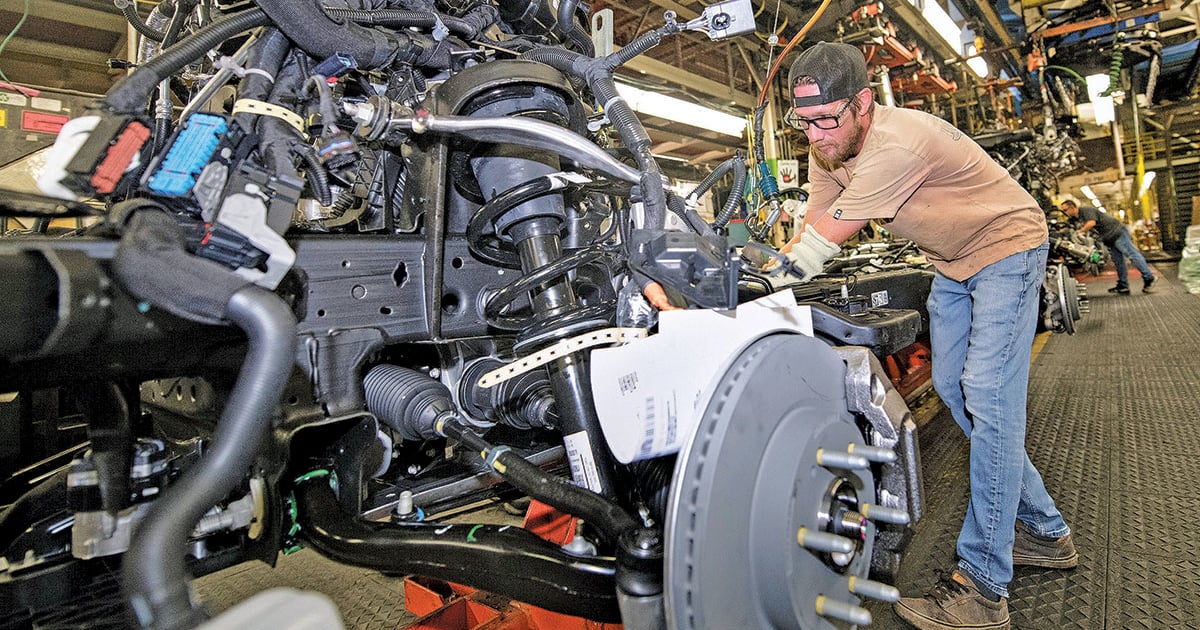
General Motors expects the large, gasoline-burning pickups and SUVs that are helping to fund its switch to electric vehicles to continue making big money for years to come.
The automaker’s commitment this month of more than $2 billion toward building its next-generation full-size pickups and SUVs all but ensures these internal combustion- powered vehicles will be rolling off assembly lines well into the 2030s.
And, labor experts say, the investment flurry amounts to GM’s opening move in this year’s contract talks with unions in the U.S. and Canada, aiming to assuage concerns that employees won’t have jobs in the future at internal combustion factories.
“We want to find a solution that’s good for our employees, good for the company, because we need to continue to reinvest,” Barra said of union negotiations. “Right now, we’ve made some important announcements about reinvesting in these plants because I think job security is very important. To do that, the company has to be successful so we can continue to develop new products that customers want to buy.”
The large pickups and SUVs built at plants in Michigan, Texas, Indiana and Ontario, are key contributors to GM’s profitability. The automaker did not discuss details or production timing of the redesigned light- and heavy-duty Chevrolet Silverado and GMC Sierra or its Chevy Tahoe and Suburban, GMC Yukon and Cadillac Escalade SUVs.
But Sam Fiorani, vice president of global vehicle forecasting at AutoForecast Solutions, said next-generation Silverado and Sierra pickup production is projected to start in 2027, with production of the overhauled SUVs to follow in early 2028. Based on a typical life cycle, that timing would keep those vehicles on assembly lines through at least the early 2030s, if not longer, he said, because it will take time to develop electric versions that can accommodate owners’ hauling and towing needs.
“For years, they have been worried about all the rumors that it takes fewer people to build an electric vehicle, so when you hear that as an assembly line worker, you fear for your job,” Fiorani said. Seeing the company invest billions of dollars in internal combustion plants “calms your nerves, at least for this contract.”
Over a seven-day span this month, GM committed to spending more than $2.3 billion at plants in Flint, Mich.; Arlington, Texas; Roanoke, Ind.; and Oshawa, Ontario.
Those plants will continue to be a focus of GM’s internal combustion production into the future, even as it aims to electrify its light-duty lineup by 2035, Gerald Johnson, GM’s executive vice president of global manufacturing and sustainability, told Automotive News.
Company leaders believe the automaker can train its workers to build EVs and their parts as production ramps up, while maintaining internal combustion production for years, he added.
All signs point to “a growing number of people that are saying that they’re interested in their next vehicle being an EV,” Johnson said. “And then there’s still those who said, ‘My truck and the functionality that I have in my truck is what I’m married to. Please don’t stop.’ … We can do both, and we will do both.”
Full-size pickups and SUVs are critical vehicles because the profits they generate power the company’s future investments, said Paul Waatti, manager of industry analysis at AutoPacific Inc.
They’re also some of the most difficult vehicles to make electric because of their size, he added.
“With all the headlines and focus on EVs and the surrounding investments, it’s easy to think the transition is right around the corner,” Waatti said. “The reality is, it’s a decadeslong transition, not a yearslong, and nowhere is that more true than with full-size pickups and SUVs. They will definitely be among the last to go exclusively EV.”
The UAW has taken a more aggressive stance under new leadership, the first to be directly elected by rank-and-file members. President Shawn Fain and his top negotiators say they are willing to strike the Detroit 3 if the automakers won’t meet their demands.
The statements GM released about its investment quote UAW Vice President Mike Booth, who leads the union’s GM department, praising the automaker for continuing to build vehicles in the U.S.
“When business is booming as it has been for the past decade — due to the hard work of UAW members — the company should continue to invest in its work force,” Booth said.
“It is good to see that GM recognizes the hard work you, the UAW membership, contribute to the success of this company.”
The UAW’s rhetoric so far suggests it will be “far less tolerant of concessions, and it’s going to want to see commitments from the company to preserve jobs in the internal combustion engine part of the equation — or at least ensure that when they transition to electrification that as many of those workers are protected as possible,” said Marick Masters, a management professor at Wayne State University in Detroit.
GM removed the fate of these plants being decided in contract negotiations by announcing investments in advance, said Art Wheaton, director of labor studies at Cornell University. That leaves tougher issues for the bargaining table, such as production of EVs, components and batteries.
Investing now also could ensure a smooth launch for these next-generation pickups and SUVs by giving GM enough lead time to start acquiring necessary tooling given the potential for a strike, he said.
“I’m sure there will be lots of different investment discussions at the table still, but if you make all of your bread and butter and the vast majority of your profits [from pickups and SUVs], you really don’t want that hanging out in the balance,” Wheaton said. “You want as much of that done ahead of time.”

